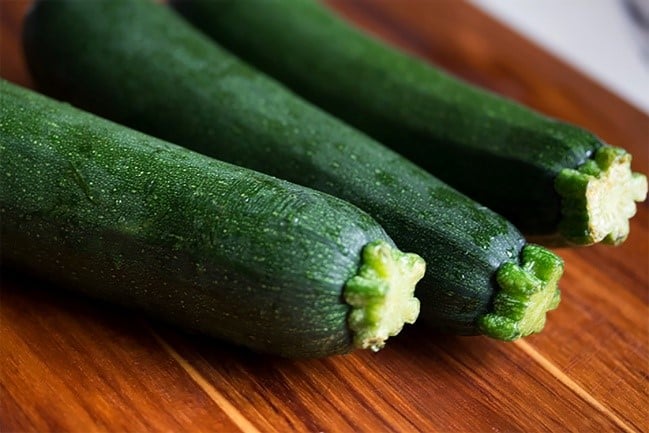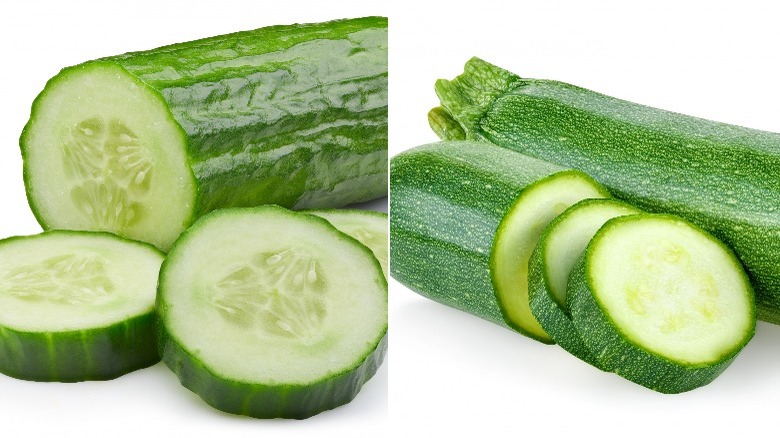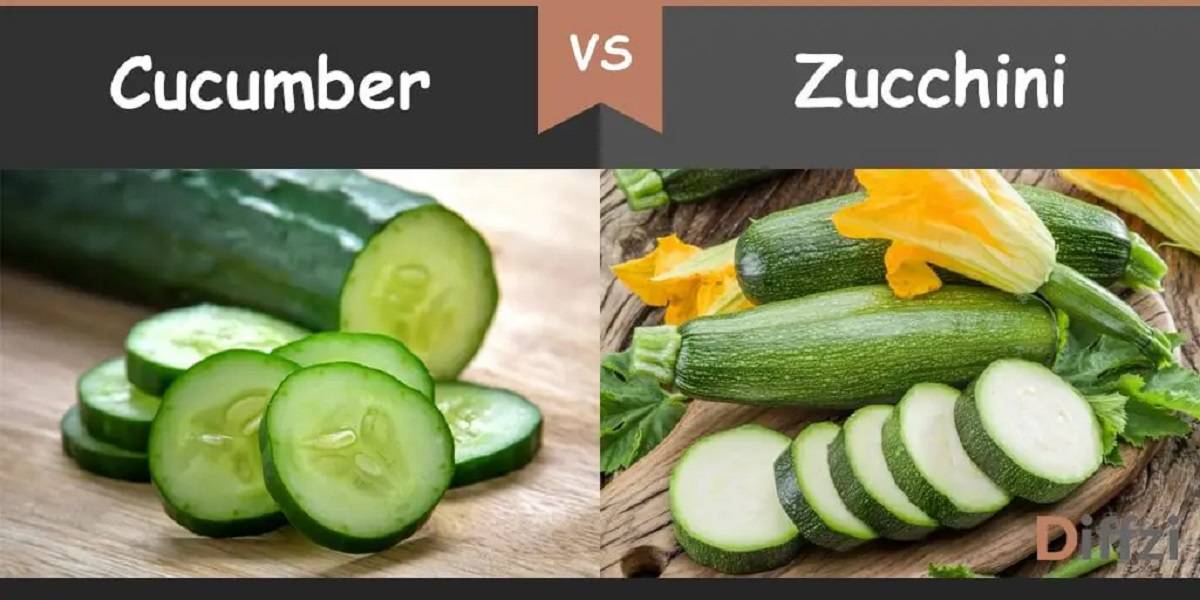Uncovering the Similarities and Differences
Zucchini and cucumber are two popular summer squash varieties that often get confused with each other due to their similarities in appearance and culinary uses. Both belong to the Cucurbitaceae family and are characterized by their warm-season growth, versatility in cooking, and refreshing flavor profiles. However, distinguishing between zucchini and cucumber is crucial for various reasons, including their unique nutritional profiles, cooking requirements, and potential health benefits. For instance, zucchini is higher in antioxidants and fiber, while cucumber is lower in calories and richer in water content. Moreover, zucchini is often used in savory dishes, such as bread, pasta, and stir-fries, whereas cucumber is commonly used in salads, sandwiches, and as a snack. To make informed decisions about which vegetable to use in different recipes and to reap their specific health benefits, it’s essential to learn how to tell the difference between zucchini and cucumber. In this article, we’ll delve into the visual cues, texture, taste, culinary uses, nutritional differences, and growing requirements of these two summer squash varieties, providing you with a comprehensive guide to identifying and utilizing them effectively.
Visual Cues: Shape, Size, and Color
One of the most effective ways to tell the difference between zucchini and cucumber is by examining their physical characteristics. Zucchini typically has a more rounded tip and a slightly bulbous shape, while cucumber is longer and more cylindrical in shape. Zucchini also tends to be smaller in size, usually around 6-8 inches in length, whereas cucumber can grow up to 12 inches or more. In terms of color, zucchini often has a darker green skin with lighter green stripes, while cucumber has a lighter green skin with a more uniform color. By paying attention to these visual cues, you can easily identify which vegetable is which. For example, if you’re at the grocery store and see a vegetable with a rounded tip and darker green skin, it’s likely zucchini. On the other hand, if you see a longer, more cylindrical vegetable with a lighter green skin, it’s probably cucumber. By learning how to identify these visual differences, you’ll be able to make more informed decisions when cooking and preparing these vegetables.
Texture and Skin: A Closer Look
Another way to distinguish between zucchini and cucumber is by examining their texture and skin. Zucchini has a slightly thicker skin that is often more tender and easier to slice, while cucumber has a thinner, more delicate skin that is often more prone to bruising. Additionally, zucchini tends to have a more ridged and bumpy texture, while cucumber is typically smoother and more uniform. When it comes to prickliness, zucchini often has small, soft spines on its skin, while cucumber is generally spineless. By paying attention to these differences in texture and skin, you can easily identify which vegetable is which. For example, if you’re handling a vegetable with a thicker, more tender skin and a ridged texture, it’s likely zucchini. On the other hand, if you’re handling a vegetable with a thinner, smoother skin and no spines, it’s probably cucumber. By learning how to identify these differences, you’ll be able to make more informed decisions when cooking and preparing these vegetables, and you’ll be able to appreciate their unique characteristics and uses.
Taste and Flavor: A Culinary Perspective
When it comes to taste and flavor, zucchini and cucumber have distinct profiles that can help you tell them apart. Zucchini has a sweeter, nuttier flavor, while cucumber is known for its refreshing, cooling taste. Zucchini also tends to have a slightly bitter undertone, while cucumber is generally milder. When cooking with these vegetables, you can use their unique flavor profiles to enhance the dish. For example, zucchini pairs well with herbs like basil and oregano, while cucumber is a great addition to salads and sandwiches. By understanding the taste and flavor differences between zucchini and cucumber, you can make informed decisions about how to use them in your cooking and recipes. Additionally, if you’re trying to decide which vegetable to use in a particular dish, you can consider the flavor profile you’re aiming for. If you want a sweeter, more robust flavor, zucchini might be the better choice. If you’re looking for a refreshing, cooling taste, cucumber is the way to go. By learning how to tell the difference between zucchini and cucumber, you’ll be able to unlock their unique flavor potential and take your cooking to the next level.
Culinary Uses: Where to Use Each
When it comes to cooking, zucchini and cucumber have different strengths and weaknesses. Zucchini is a versatile vegetable that can be grilled, sautéed, baked, or spiralized into noodles. It’s a great addition to pasta dishes, stir-fries, and casseroles. Cucumber, on the other hand, is best used in salads, sandwiches, and as a snack. Its refreshing flavor and crunchy texture make it a great addition to dishes like tzatziki sauce, salads, and wraps. When deciding which vegetable to use in a particular dish, consider the flavor profile and texture you’re aiming for. If you want a heartier, more filling dish, zucchini might be the better choice. If you’re looking for a light and refreshing addition to a salad or sandwich, cucumber is the way to go. By understanding the culinary uses of each vegetable, you can make informed decisions about how to use them in your cooking and recipes. For example, if you’re making a stir-fry, zucchini’s slightly sweet flavor and tender texture make it a great addition. If you’re making a salad, cucumber’s refreshing flavor and crunchy texture make it a great choice. By learning how to tell the difference between zucchini and cucumber, you’ll be able to unlock their unique culinary potential and take your cooking to the next level.
Nutritional Differences: A Health Perspective
When it comes to nutrition, zucchini and cucumber have different profiles that can impact their health benefits. Zucchini is higher in antioxidants, vitamin C, and potassium, making it a great choice for boosting immune function and heart health. Cucumber, on the other hand, is lower in calories and higher in water content, making it a great choice for weight management and hydration. Additionally, cucumber contains anti-inflammatory compounds like fisetin, which has been shown to have anti-cancer properties. When choosing between zucchini and cucumber for specific health benefits, consider the nutritional differences. For example, if you’re looking to boost your immune function, zucchini’s high vitamin C content makes it a great choice. If you’re looking to manage your weight, cucumber’s low calorie and high water content make it a great choice. By understanding the nutritional differences between zucchini and cucumber, you can make informed decisions about how to incorporate them into your diet for optimal health benefits. By learning how to tell the difference between zucchini and cucumber, you’ll be able to unlock their unique nutritional potential and take your health to the next level.
Growing and Harvesting: A Gardener’s Perspective
For gardeners, understanding the growing and harvesting requirements of zucchini and cucumber is crucial for a successful crop. Both vegetables prefer well-draining soil and full sun, but zucchini requires more moisture and fertilizer than cucumber. Zucchini also has a shorter maturation period, typically taking around 35-45 days to harvest, while cucumber takes around 50-60 days. When it comes to harvesting, zucchini is typically picked when it reaches 6-8 inches in length, while cucumber is picked when it reaches 10-12 inches in length. By understanding the unique growing and harvesting requirements of each vegetable, gardeners can optimize their crop yields and enjoy a bountiful harvest. Additionally, learning how to identify each vegetable at different stages of growth and ripeness can help gardeners determine the best time to harvest and ensure the highest quality produce. By mastering the art of growing and harvesting zucchini and cucumber, gardeners can enjoy a delicious and nutritious crop all season long.
Conclusion: A Quick Reference Guide
In conclusion, learning how to tell the difference between zucchini and cucumber is a valuable skill for any cook, gardener, or health enthusiast. By understanding the visual cues, texture, taste, culinary uses, nutritional differences, and growing requirements of each vegetable, you can make informed decisions about how to use them in your cooking and recipes. Whether you’re looking to add some extra nutrition to your diet, or simply want to impress your friends with your culinary skills, being able to identify zucchini and cucumber with confidence is a must. To help you get started, here’s a quick reference guide to the key differences between zucchini and cucumber:
- Visual Cues: Zucchini has a rounded tip and a more compact shape, while cucumber is longer and more cylindrical.
- Texture: Zucchini has a thicker, more tender skin, while cucumber has a thinner, more delicate skin.
- Taste: Zucchini has a sweeter, nuttier flavor, while cucumber is refreshing and cooling.
- Culinary Uses: Zucchini is great for grilling, sautéing, and baking, while cucumber is perfect for salads, sandwiches, and snacks.
- Nutritional Differences: Zucchini is higher in antioxidants and vitamin C, while cucumber is lower in calories and higher in water content.
- Growing Requirements: Zucchini requires more moisture and fertilizer than cucumber, and has a shorter maturation period.
By following this quick reference guide, you’ll be able to tell the difference between zucchini and cucumber with ease, and unlock their unique culinary and nutritional potential.








